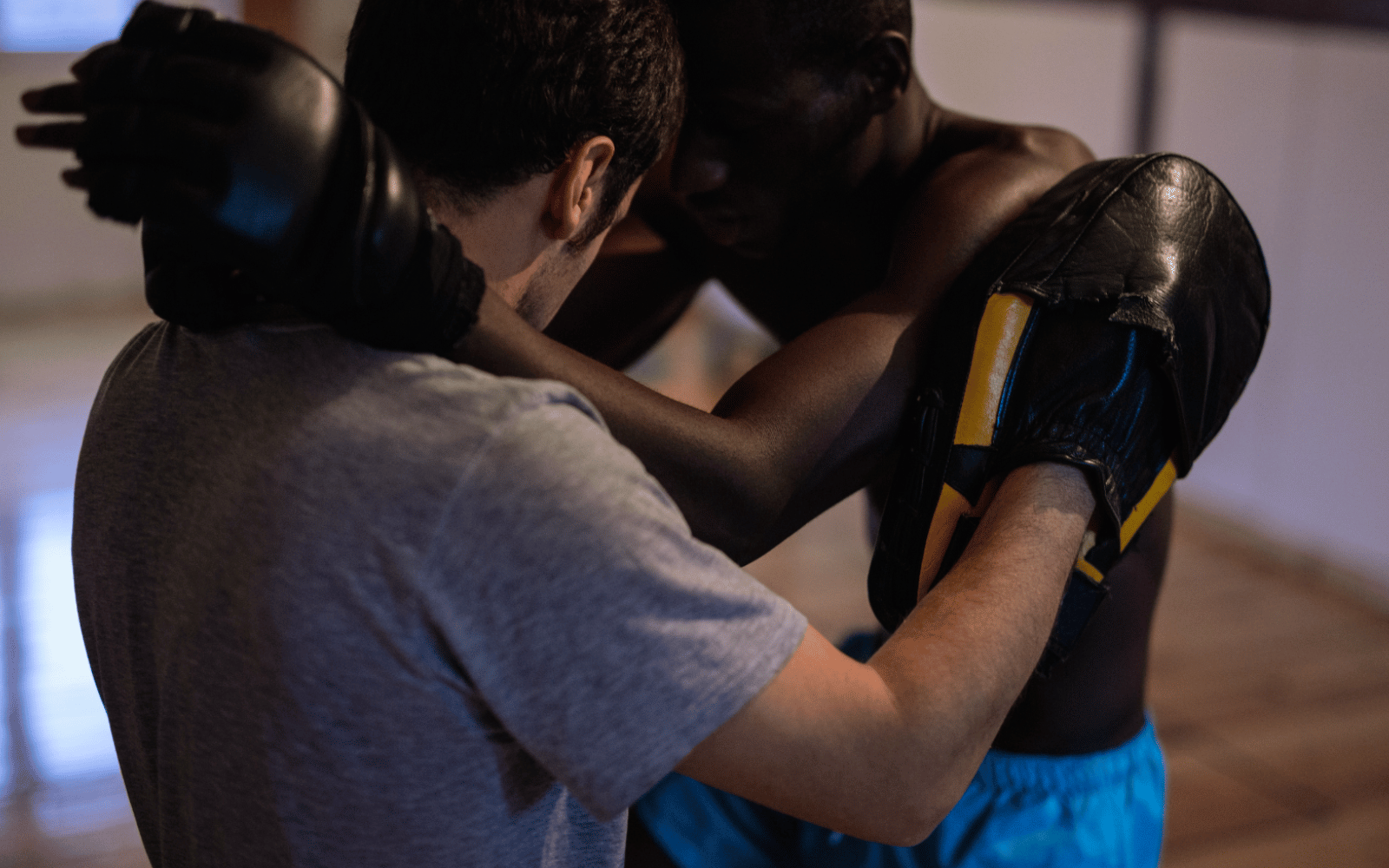While kicks, knees, and elbows often get the spotlight, the Muay Thai clinch can be an equally important technique for success.
It’s a place where raw power meets strategic finesse.
Beyond the flash of high-flying kicks, the clinch is a testament to Muay Thai’s depth and complexity, an intricate dance of control within the chaos that can lead to victory or defeat.
Dive into the world of clinching, from the muscles that power its techniques to its storied history in MMA, and discover the art and science behind one of Muay Thai’s most captivating components.
- What Is The Muay Thai Clinch?
- Muay Thai Clinch Techniques
- Muay Thai Clinch Entry & Exit
- Offensive Clinching
- Strikes in the Clinch
- Throws And Sweeps in the Muay Thai Clinch
- Defensive Clinching
- Common Mistakes With Muay Thai Clinching
- Training Tips For Effective Clinching
- Muay Thai Clinch Bag Drills
- Best Clinch Fighters in Muay Thai History
- Best Uses of Muay Thai Clinch in MMA
- Is Clinching Illegal in Kickboxing?
- What Muscles Are Used in Clinching?
- Closing in on the Muay Thai Clinch
What Is The Muay Thai Clinch?
The Muay Thai clinch is a thrilling and crucial aspect of Muay Thai. It’s a unique grappling technique that separates it from many other striking disciplines like straight kickboxing.
Fighters use their hands to grip their opponent’s head or neck. The goal is to off-balance opponents by controlling their upper body and setting them up opponents for knees, elbows, or sweeps.
It’s both offensive and defensive, requiring skill and technique to control an opponent and avoid their attacks.
And it’s exactly what we’re exploring in-depth below.
Difference Between Clinching in Muay Thai vs Boxing
The major difference between the clinch in boxing vs Muay Thai is its purpose.
The Muay Thai clinch is used for offense, control, and continuous action. It’s an active and strategic position where fighters fight for a dominant position to manipulate their opponents’ posture for attack.
Fighters can use a variety of attacks, primarily knee and elbow strikes, as well as trips and sweeps.
Here is what the Muay Thai clinch looks like:
As you can see, it’s fast paced, aggressive, and offers a variety of attacks.
The boxing clinch meanwhile, is typically used to stall or neutralize the action temporarily.
It’s more a defensive tactic fighters use to make their opponent carry their weight and further tire them or prevent their opponent from hitting, especially when they’re tired and want to reset.
In this clinch, fighters usually wrap their arms around the opponent’s arms or torso for a body lock.
And unlike the Muay Thai clinch, there’s limited to no striking from this position, and referees will typically break up the fighters after a short period.
Muay Thai Clinch Techniques
There are many different ways to engage the clinch game with basic to advanced techniques.
Over-Under Position
The over-under position involves getting one overhook and one underhook on your opponent. Usually this means grabbing over their arm on one side while getting an underhook around their arm on the other side with your other arm.
From here you can land knees to the exposed body side. And this can be an excellent transitional position to move into other clinch holds like the double underhooks (described down below).
To maximize control, keep your elbows tight and hips in close. Posture upright and sink your weight down through your legs. Don’t overextend your arms. And use the asymmetrical grip to off-balance and manipulate your opponent.
Single Collar Neck Tie
Single collar ties use one hand to grip the back of an opponent’s neck, pulling their head down towards them.
The other arm can then be used to strike or used defensively, pushing up against the opponent’s chest or guarding against strikes.
The fighter must use tight bicep control to handle their opponent’s posture and set up knee strikes or other clinch techniques from this one-handed grip on the neck.
Double Collar Neck Tie (Plum)
The double collar tie is the commonly seen Muay Thai clinch grip. It’s a tight, controlled embrace around the opponent’s head using both hands.
To do it, you reach up over both sides of your opponents neck to grip behind their shoulders. You then clamp down firmly with both hands to control their head and arch their posture backwards. You must keep your elbows down to frame against their shoulders and sink your weight to maximize leverage and prevent them spinning out.
From here you can land devastating straight knees up the middle to your opponent’s chin and torso. And use the grip to maneuver them, disrupt balance, and set up transitions to other clinch positions.
To maximize control, keep your back upright and core engaged. And try not to over-extend.
Double Underhooks
Not as commonly used in traditional Muay Thai as it is in MMA, the double underhooks clinch is very effective.
You reach both arms under and around your opponent’s arms to lock your hands together behind their back, pressing your forearms into their armpits or ribcage.
Use this clinch grip to arch your opponent’s body backwards, disrupting their posture and balance. But always keep your elbows tight, maintain an upright posture, and sink your weight down to maximize control and leverage.
From here, you can unleash powerful knees to the torso. And the double underhook and gives you great control to set up throws, dumps, or transitions, especially against a taller opponent.
Muay Thai Clinch Entry & Exit
Successfully entering and exiting a clinch unscathed requires a surprising level of skill…
Entry: How To Start a Clinch
Engaging a Muay Thai clinch involves closing the distance between you and your opponent and establishing a grip.
And doing so within the Muay Thai rules looks like this:
- Close the distance: The first step is to close the distance. you must move closer to your opponent either by stepping in, using punches or kicks as cover or by slipping or parrying their strikes to get into clinch range.
- Hand positioning: As you close the distance, you must get your hands on your opponent. The goal is to secure a grip on the back of their head or neck, but this can also start by controlling their arms or shoulders.
- Establish the clinch: Once you’re in range and have made initial contact, you’ll then start your preferred clinch positional control (single collar tie, double collar tie, over-under, etc.). This often involves pulling the opponent’s head down while keeping your elbows tight to protect against their strikes.
- Posture and balance: Keep a strong stance with your hips slightly forward. This provides stability and prevents your opponent from easily pulling you off balance. At the same time, use your clinch grip to disrupt their posture, making it hard for them to land a powerful strike or resist effectively.
- Defense: Always be aware of your opponent’s potential strikes, especially knees and elbows. Proper positioning and posture can minimize these threats.
- Evolve Your Control: Since the clinch is highly dynamic, you must always be prepared to adjust your grip, switch positions, or disengage if necessary.
Exit: Escaping a Muay Thai Clinch
And that’s why knowing HOW to exit or disengage the clinch is just as important and requires a combination of technique, timing, and awareness.
Here’s one way you can do it:
- Create space: To do this, you must use your forearms or hands to push against your opponent’s chest or shoulders. This helps create a buffer zone, making it harder for them to strike as you exit.
- Break the grip: If your opponent has a strong single or double grip on your neck or head, use your hands to break their grip. This is easier said than done but can be done by pushing on their elbows, peeling their hands away, or using a quick jerking motion to disrupt their hold and balance.
- Posture up: Make sure to lift your head and straighten your back. This reduces your opponent’s control and makes it harder for them to pull you back into the clinch, where they can easier control you.
- Footwork: Use lateral movement or quick backward steps to help create that important distance. But you’ll want to avoid moving straight back for too long, as this can leave you vulnerable to strikes.
- Defensive guard: As you exit the clinch, you’ll want a tight guard. Bring your hands up to a defensive position to protect against potential strikes, especially kicks or punches the opponent might throw as you disengage.
- Use strikes: A well-timed strike, such as a push kick (teep) or an elbow, can create space and deter your opponent from pursuing you immediately.
- Change levels: If you’re struggling to break free, consider changing levels by dropping your weight (just be careful of incoming knees) and attempting a takedown or sweep. This can disrupt your opponent’s balance and provide an opportunity to disengage.
- Stay alert: Even after you’ve exited the clinch, remain alert. The transition from clinch to striking range is a critical moment where both fighters can be vulnerable.
Offensive Clinching
Offensive clinching refers to the proactive use of the clinch position to set up strikes or manipulate an opponent’s position for a tactical advantage.
Instead of using the clinch merely as a means of defense or stalling, the fighter seeks to actively dominate and exploit the situation.
And like any martial art, there exist different fighting styles within Muay Thai. After all, everyone has different sensibilities with different body types.
And the Muay Thai style known as Muay Khao (sometimes referred to as knee fighters) is especially good at offensive clinching. It’s an advanced and technical style that relies heavily on knees and clinches to fatigue and decimate opponents.
So, in essence, offensive clinching is about turning the clinch position into an active battleground where fighters, like those with the Muay Khao style, continuously seek out opportunities to attack, dominate, and outmaneuver opponents.
Strikes in the Clinch
There are lots of effective strikes that have evolved for the clinch game.
Elbows
Elbow strikes can be delivered from various positions within the clinch. Still, they are usually thrown when a fighter creates a slight separation or finds an opening in the opponent’s defense.
But proper technique and timing are crucial regardless of when they’re thrown.
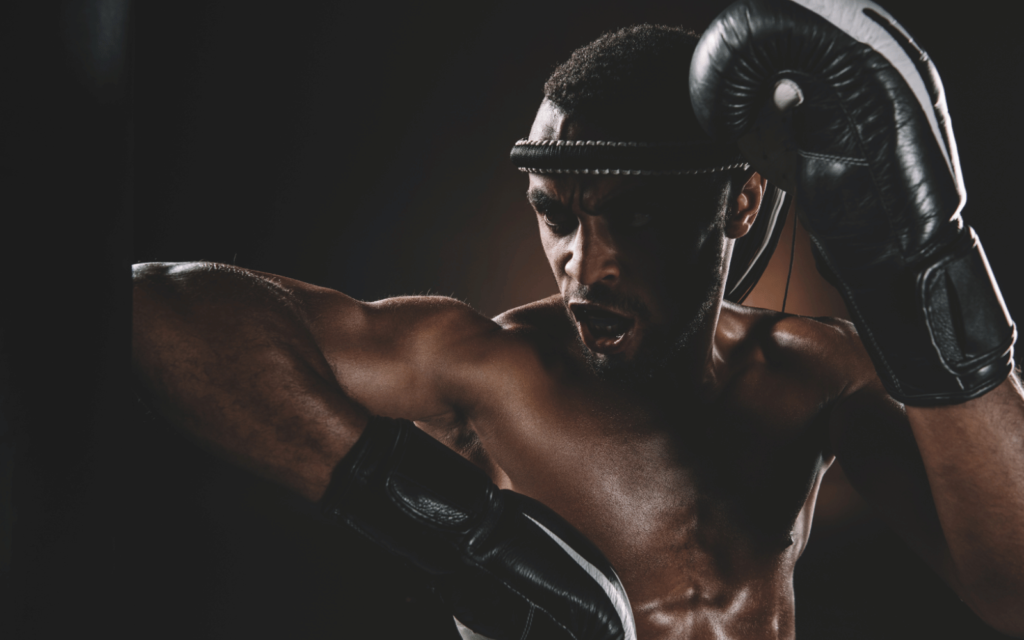
Here are some of the most commonly used elbows:
- Horizontal Elbow (Sok Tad): Swung horizontally, it targets the opponent’s jaw, temple, or cheek. It’s similar to a hook in boxing but uses the elbow as the striking point.
- Upward Elbow (Sok Ngat): Delivered in an upward slashing motion, it aims for the opponent’s chin or nose, somewhat resembling an uppercut.
- Downward Elbow (Sok Tong): Struck in a downward chopping motion, it targets the forehead or the bridge of the nose.
- Forward Thrust Elbow (Sok Phong): Thrusted straight forward like a jab, this elbow targets the opponent’s face, especially the nose.
- Reverse Horizontal Elbow (Sok Wiang Klap): This involves twisting the body and striking the opponent with the backside of the elbow, targeting areas like the temple or jaw.
- Spinning Back Elbow (Sok Klap): As the name suggests, the fighter spins and strikes with the back of the elbow, targeting the opponent’s face or temple.
- Side Elbow (Sok Klap): This is executed by turning slightly to the side and striking the opponent with the outer part of the elbow, usually to the temple or side of the head.
Knees
In the Muay Thai clinch, using knee strikes effectively requires strength, timing, precision, and manipulation of your opponent’s balance and posture.
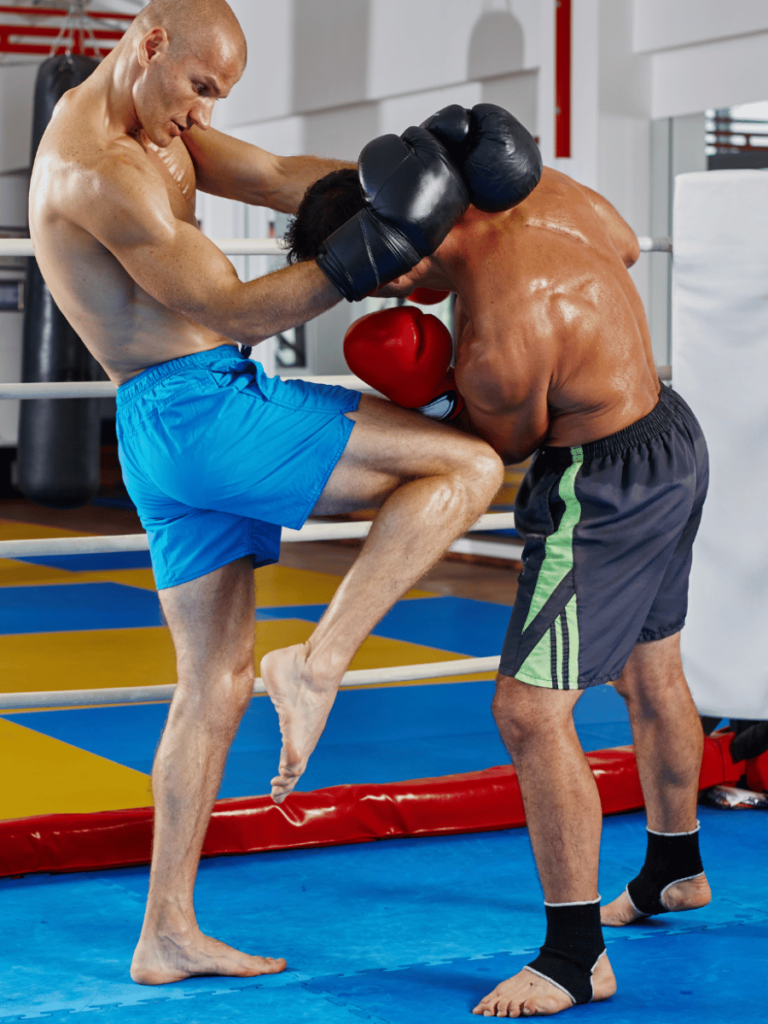
You must control your opponent’s hips and shoulders, break their posture, and create angles to land powerful knee strikes in the clinch.
And here are some go-to’s to practice:
- Straight Knee (Khao Trong): A direct thrusting knee strike aimed at the opponent’s torso. The fighter drives the knee straight up the middle, targeting the ribs, abdomen, or chest.
- Curved Knee (Khao Krong): Delivered in a diagonal or curved motion, this knee targets the sides of the opponent’s body, especially the ribs or thighs. It’s often used when one fighter is slightly off to the side of the other.
- Side Knee (Khao Chiang): A knee strike from the side, targeting the opponent’s thighs or ribs. It’s often used to damage the opponent’s legs within the clinch.
- Jumping Knee (Khao Yiep): This involves jumping and then driving the knee into the opponent. While less common in the clinch due to the limited space, it can be used when there’s a slight separation between the fighters.
- Swing Knee (Khao Loi): Similar to the curved knee but thrown with more of a swinging motion, often aimed at the opponent’s head when they are bent over or their posture is broken down.
- Downward Knee (Khao Tot): Struck downwards, targeting the thighs or hips of the opponent. This can help limit the opponent’s mobility or set up other techniques.
Throws And Sweeps in the Muay Thai Clinch
A Muay Thai clinch practitioner doesn’t just strike. They also use footwork and leverage to off-balance, dominate, and potentially score points with trips and sweeps.
Here are some common techniques:
- Outside Leg Sweep (Dao Tok): While clinching, a fighter uses the outside of their foot or leg to sweep the inside of the opponent’s standing leg, causing them to fall.
- Inside Leg Sweep (Dao Nang): The fighter hooks their foot inside behind the opponent’s leg and sweeps it outwards.
- Backward Foot Push (Teep Kha): If an opponent is pushing forward aggressively in the clinch, the fighter might redirect this momentum and push the opponent’s leading foot backward with their own foot, causing the opponent to fall back.
- Body Turn and Throw (Wiang San): The fighter uses their body and arm positioning to twist your opponent off balance, throwing them to the side or forward.
- Knee Catch and Sweep: When the opponent attempts a knee strike, the fighter can catch the kneeing leg under their armpit and then sweep the standing leg out from under them.
- Head Pull Down and Leg Trip: A fighter pulls the opponent’s head downwards while simultaneously tripping them with their leg. This is especially effective when the opponent resists the downward pull and their leg becomes light.
- Shoulder Spin Throw: By applying pressure on the opponent’s shoulder and turning it, the fighter can spin the opponent and make them lose balance.
- Hip Throw (similar to Judo’s Koshi Guruma): While not as common, a fighter can use their hip as a lever, throwing the opponent over it when they get the right angle and leverage in the clinch.
Defensive Clinching
Being in the clinch doesn’t mean you’re always attacking.
Sometimes, you’re defending against your opponent’s knee strikes, trying to move their head to the side, or even attempting to “break” the clinch to reset to a more comfortable distance.
Underhook Defense
The underhook defense is where your arm goes underneath the opponent’s arm and hooks around, usually aiming for the mid-back or shoulder blade.
Achieving underhooks generally gives a fighter more control in the clinch. Defensively, there are several strategies:
- Pummeling: This involves swimming your arms inside to regain inside control or achieve your own underhooks. The goal is to not allow your opponent to establish a secure underhook position.
- Posture: Keeping an upright posture can prevent an opponent from fully capitalizing on their underhooks. By staying tall and straight, you limit their ability to manipulate your body.
Muay Thai Clinch Footwork Techniques
- Pivoting: This involves turning on one foot to change your angle relative to your opponent. By pivoting, you can off-balance an opponent or escape from a compromising position.
- Lateral Movement: Instead of moving straight back, move side to side. This makes it harder for the opponent to predict your movement and press forward aggressively.
- Level Changes: By changing your level (dropping your base or bending your knees), you can avoid certain strikes or manipulations and set up potential counters.
- Stepping Out: If an opponent is pressing forward, you can step to the side and slightly back, redirecting their momentum and potentially creating an angle for offense or further defense.
- Backpedaling: Sometimes, creating distance quickly is necessary, especially if you’re trying to break out of the clinch. However, it’s essential to do this strategically, so you don’t get caught with strikes as you move back.
Common Mistakes With Muay Thai Clinching
When learning the Muay Thai clinch, it’s common for practitioners (Nak Muay) to make certain mistakes. Here are some of the most frequent ones to be aware of:
Poor Posture
Slouching forward can expose you to knees to the face.
So, not keeping your back straight and head up can leave you vulnerable to strikes and manipulations.
Over-relying on Strength
Muscle power alone won’t win in the clinch.
Like in BJJ, technique, leverage, and timing are often more critical in Muay Thai grappling.
Relying too much on strength can also tire you out quickly.
Forgetting Defense
Being too focused on offensive techniques can open you up to elbows and knees.
So, you should always be mindful of your defensive posture and positioning.
Not Controlling the Opponent’s Arms
If you allow your opponent’s arms inside yours, they can easily control your posture and potentially land strikes.
Fight for inside arm control or at least be constantly aware of their arm placement.
Static Gripping
Holding onto one type of grip without making adjustments can be predictable and ineffective. The clinch is dynamic; transitioning between grips and positions can create more opportunities.
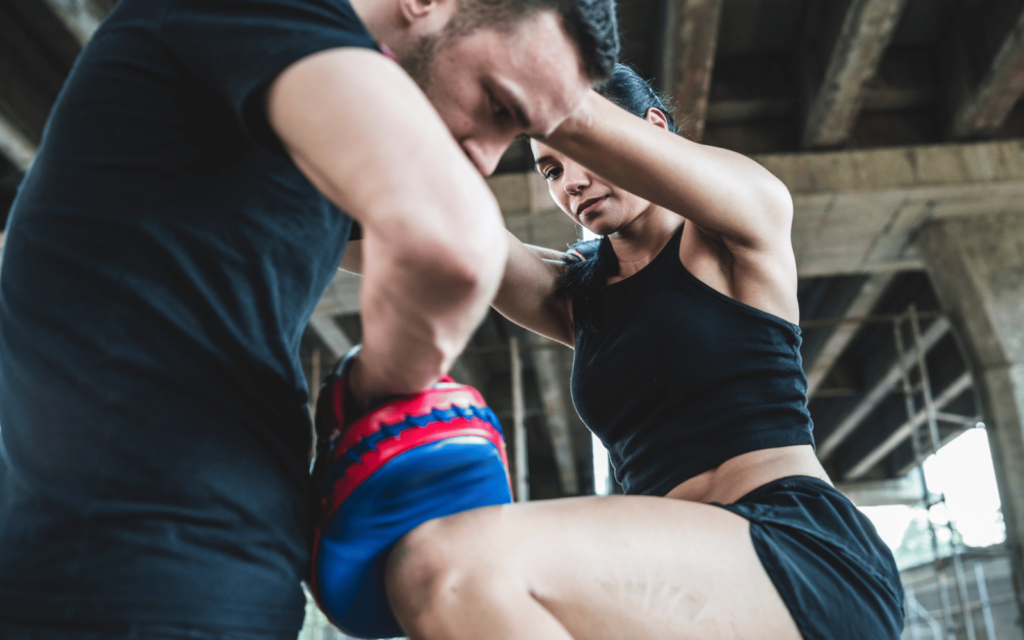
Ignoring Footwork
Proper foot placement and balance are essential. If your legs are too close together or too squared up, you’re easier to sweep or off-balance.
Telegraphing Moves
If you make your intentions too obvious, your opponent can easily counter. For example, if you always pull the head down the same way for a knee strike, an experienced opponent will anticipate and counter.
Forgetting to Breathe
Holding your breath, especially when exerting force or defending, can fatigue you rapidly. Continuous, controlled breathing is crucial.
Neglecting to Break or Reset
Sometimes it’s beneficial to disengage, reset, and re-enter the clinch rather than struggling in a compromised position.
Overcommitting to Sweeps or Throws
If you go for a sweep or throw and put all your weight into it without setting it up properly, you might end up off-balancing yourself instead.
Not Drilling Transitions
The clinch isn’t just about holding; it’s about transitioning between positions, strikes, and defenses. Regularly drilling transitions can improve fluidity and responsiveness.
Failing to Sense Opponent’s Weight
Feeling where your opponent’s weight is distributed helps in off-balancing them. If you don’t pay attention to this, your sweeps and throws might be ineffective.
Training Tips For Effective Clinching
Here are some key clinch training tips to help you improve:
- Technique First: Before adding speed or strength, correct your technique. This is where a knowledgeable instructor can provide valuable guidance and feedback.
- Drill Regularly: Repeatedly practice clinch entries, exits, transitions, and throws. Repetition helps ingrain techniques to muscle memory. And even kids can train Muay Thai – so best to start training asap!
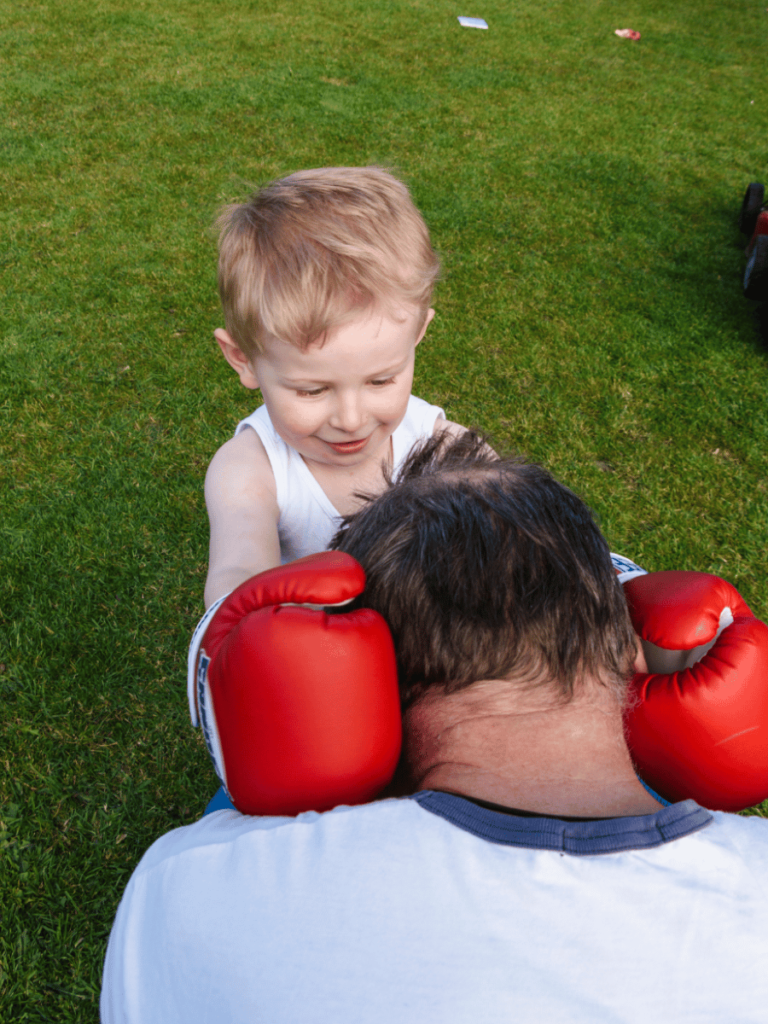
- Strength and Conditioning: While technique is paramount, having strength and cardio is key – especially in your neck, shoulders, and core. This can give you an edge in the clinch. Exercises like planks, neck bridges, and pull-ups are great for this.
- Practice with Different Partners: Everyone clinches differently and may gravitate towards a single collar more than a double or vice versa. Training with various partners helps you adapt to different styles, strengths, and sizes.
- Stay Relaxed: Tensing up can tire you out quickly and make your movements predictable. Staying relaxed allows for quicker reactions and better endurance. And it’s best done through practice and building up comfort over time.
- Spar Regularly: Sparring in the clinch under controlled conditions will give you practical experience. It helps you apply what you’ve learned in drills to real-life situations.
- Focus on Balance: Understanding your balance and your opponent’s is key. Practice shifting your weight and recognizing when your opponent is off-balance.
- Breathing: Ensure you’re breathing consistently. Holding your breath can exhaust you and limit your performance.
- Defensive Drills: Spend time specifically working on defensive clinching techniques. Being able to defend and counter in the clinch is as vital as offense.
- Stay Active: In the clinch, always be doing something – whether it’s adjusting your grip, striking, off-balancing your opponent, or defending.
- Learn from Fights: Watch professional Muay Thai fights, paying close attention to clinch work. Analyze their movements, strategies, and techniques.
- Feedback: Regularly ask your training partners and instructors for feedback. They might notice habits or mistakes that you’re not aware of.
- Continuous Learning: Even if you feel proficient, there’s always something more to learn or refine. Stay open to new techniques or strategies.
- Simulate Fight Conditions: Occasionally, practice clinching with rounds, mimicking fight conditions. It helps you understand how to manage energy and strategy in a timed setting.
- Mindset: Approach clinching as a chess game, not just a physical contest. Strategy, foresight, and adaptability are critical.
Muay Thai Clinch Bag Drills
The type of punching or heavy bag you’re using can influence the kind of clinch drills you can best perform.
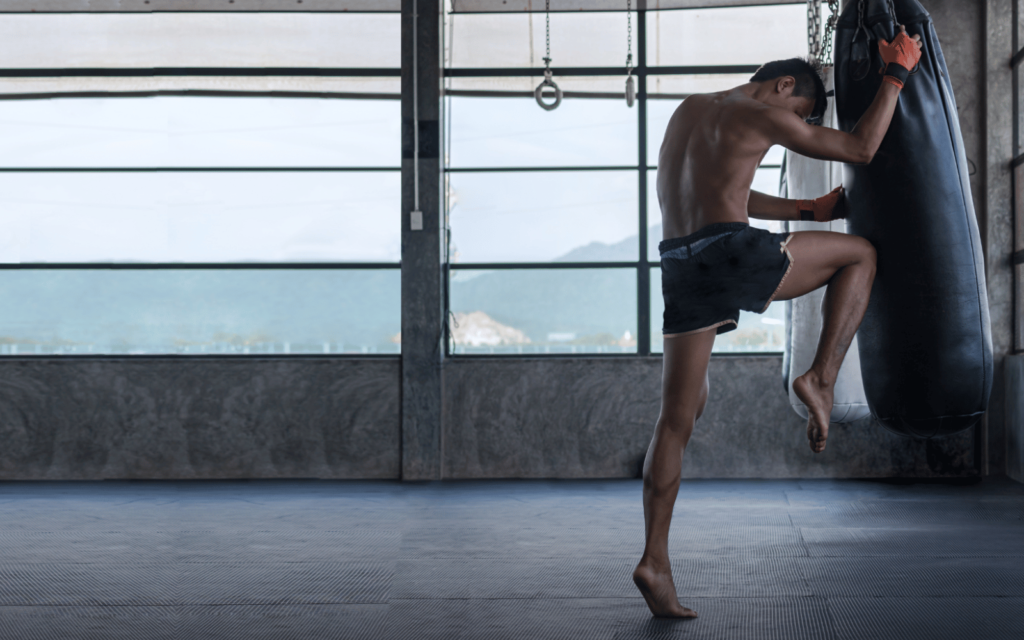
Here are some Muay Thai clinch bag drills tailored to different types of heavy bags:
Standard Heavy Bag
Clinch Grip & Knees: Grip the top of the bag and deliver alternating straight knee strikes, simulating kneeing an opponent’s midsection.
Elbow Strikes: After a set of knee strikes, create a little space and practice various elbow strikes like the upward elbow or horizontal elbow, mimicking transitions from clinching to elbowing.
Teardrop or Banana Bag
Really you can do these with any longer bags that reach the floor.
Low Knee Strikes: Due to the extended length, you can practice knee strikes targeting the legs, simulating low knee strikes to an opponent’s thighs in the clinch.
Clinch & Sweeps: Grip the bag and mimic sweeping techniques, using the foot to “sweep” the bottom part of the bag. It won’t move like a real opponent, but it helps in practicing the motion.
Uppercut or Wrecking Ball Bag
With rounded, shorter bags you can try these out:
Upper Knee Strikes: These bags hang at about torso level, making them perfect for practicing upward knee strikes, as if targeting an opponent’s face in the clinch.
Pull & Strike: Grip the bag tightly, pull it towards you, and then release, following with a knee or elbow strike, training the motion of off-balancing an opponent and striking.
Mexican Style Double-End Bag
Timing & Precision: Though not traditionally used for clinch work, the double-end bag’s movement can help improve timing and precision. Try to clinch or “catch” the bag with one hand and deliver precise knee strikes as the bag rebounds.
Thai Pole or Wall-Mounted Uppercut Bag
Static Clinch Work: Grip the pole or bag, delivering knee and elbow combinations. The stationary nature helps focus on technique and power without the movement of a swinging bag.
Transitions: Practice transitioning between various clinch grips, throwing strikes in between each transition, emphasizing fluidity and control.
Best Clinch Fighters in Muay Thai History
Here are some of the most notable clinch masters in Muay Thai history:
Dieselnoi Chor Thanasukarn
Often at the top of the list for best knee fighters, Dieselnoi was exceptionally tall, lean, and mean for his weight class and used his height advantage to dominate opponents in the clinch, delivering devastating knee strikes.
Petchboonchu FA Group
Holding the record for the most Lumpinee Stadium titles, Petchboonchu was known for his relentless clinch game and ability to wear down and outscore opponents in the clinch.
And his post-fighting career has led to numerous excellent YouTube tutorials on clinching.
Sangtiennoi Sor Rungroj
Known as the “Deadly Kisser”, Sangtiennoi was a fierce clincher and was particularly skilled at delivering powerful knee strikes from any range. Check this awesome highlights video including some cool music (a nice change from most fighter videos ;).
Saenchai PKSaenchaiGym
Although Saenchai is more widely known for his creative and flashy striking, his clinch game, particularly his ability to off-balance and sweep opponents, is top-tier.
You can see glimpses of this even in a sparring video with another incredible Muay Thai talent Tawanchai at Saenchai’s gym.
Best Uses of Muay Thai Clinch in MMA
Because of its mix of grappling with its striking, Muay Thai obviously has been a very popular addition to Mixed Martial Arts (MMA) over the years.
Here are just a few notable MMA fighters who mastered the clinch:
Anderson Silva
The former UFC Middleweight Champion famously utilized the Muay Thai clinch against Rich Franklin in their first encounter at UFC 64.
Silva controlled Franklin with a plum clinch (double collar tie) and delivered devastating knee strikes to the body and head, leading to a TKO victory.
And although Franklin trained a ton to defend it in their rematch, the outcome remained the same.
Wanderlei Silva
In PRIDE FC, Silva was feared for his aggressive style, often pushing opponents against the ropes and unleashing a barrage of punches and knees from the clinch.
Like in his epic matchup versus Rampage Jackson where he effectively utilized both single and double neck tie clinch to deliver devastating knees.
Maurício “Shogun” Rua
The former UFC Light Heavyweight Champion and PRIDE Fighting Championships star and another legendary Brazilian MMA fighter, Shogun is renowned for his aggressive Muay Thai style.
Throughout his career, he has effectively employed the Muay Thai clinch, using it to set up a series of punishing knee strikes and elbows.
His blend of Muay Thai striking with a strong grappling background made him one of the most feared fighters during his prime, with the clinch being a pivotal component of his offensive arsenal.
And despite having limited English even does a decent job of describing his effective techniques!
Is Clinching Illegal in Kickboxing?
One of the biggest differences between Kickboxing vs Muay Thai is the use of the clinch.
In most traditional kickboxing rulesets, prolonged clinching is illegal. While there might be brief moments of clinch-like engagements during exchanges, fighters are typically not allowed to maintain the clinch and actively work from it as they would in Muay Thai.
Fighters might end up in a clinch-like position after throwing a combination or a kick in kickboxing. But like the clinch in boxing, the referee will separate them if they don’t break apart within a few seconds.
But it’s also important to remember that kickboxing is a broad term that encompasses various styles. For instance, the Japanese and American styles don’t allow the clinch, but Dutch Kickboxing does.
What Muscles Are Used in Clinching?
As the art of 8 limbs, you’ll need to take a comprehensive approach to your strength and conditioning.
Muay Thai clinching engages a variety of muscle groups, given the dynamic nature of controlling, striking, and attempting to off-balance an opponent.
Here are the primary muscles involved:
- Neck Muscles: Strong neck muscles allows a fighter to resist being controlled by the head and maintain upright posture.
- Sternocleidomastoid and Scalenes: These muscles on the sides of the neck help in resisting an opponent’s pull and maintaining head posture.
- Upper Trapezius and Levator Scapulae: Used to shrug and lift the shoulders, providing protection and stability in the clinch.
- Back and Shoulders: The large upper back/neck muscles are used for stabilizing the scapula and holding clinch positions.
- Rhomboids and Middle/Lower Trapezius: These muscles retract the scapula, helping pull the opponent closer and maintaining control.
- Deltoids: The shoulder muscles engaged when applying pressure, pummeling for control, or delivering strikes.
- Latissimus Dorsi: The wide, triangular back muscles engaged when pulling an opponent closer or down and when resisting their attempts to break the clinch.
- Erector Spinae: These run along the spine and are essential for maintaining an upright posture and resisting an opponent’s attempts to bend you forward.
- Chest: Strong chest muscles give stability and strength in the shoulders and upper body, essential for controlling clinch positions.
- Pectoralis Major and Minor: Used during pummeling, pulling an opponent, and when applying pressure forward.
- Core: Flexing the torso and spine for posture.
- Rectus Abdominis, Obliques, and Transverse Abdominis: These muscles provide stability, allow for twisting movements, and are engaged when delivering knee strikes or resisting an opponent’s movements.
- Hips and Thighs: Key for powerful hip extension for knees and posture
- Hip Flexors (Iliopsoas): Crucial for lifting the knee to deliver knee strikes.
- Glutes and Hamstrings: Engaged during knee strikes, maintaining a strong base, and when attempting sweeps or off-balancing techniques.
- Adductors: These inner thigh muscles play a role in squeezing the opponent’s body, controlling their posture, and in certain sweeps.
- Forearms and Arms: Grip strength and arm endurance for maintaining clinch grips.
- Biceps and Brachialis: Engaged when pulling the opponent or resisting their attempts to break free.
- Forearm Muscles (like Flexor Digitorum Profundus): Essential for maintaining a tight grip on the opponent.
- Calves: Anchoring the feet and stabilizing on knees or clinch throws.
- Gastrocnemius and Soleus: These provide stability, help in quick foot movements, and play a role in certain off-balancing techniques.
Incorporating strength and conditioning exercises that target these muscle groups can enhance a fighter’s efficiency and effectiveness in the Muay Thai clinch.
Closing in on the Muay Thai Clinch
So there you have it.
The Muay Thai clinch is incredibly important for the combat sport.
It’s what differentiates it from other
